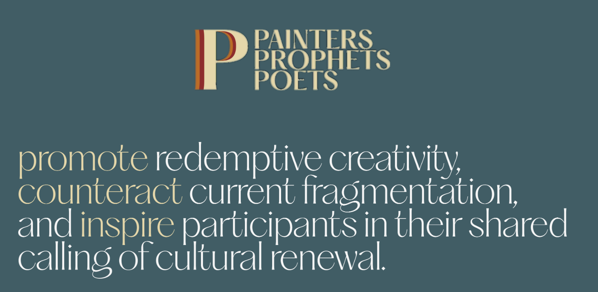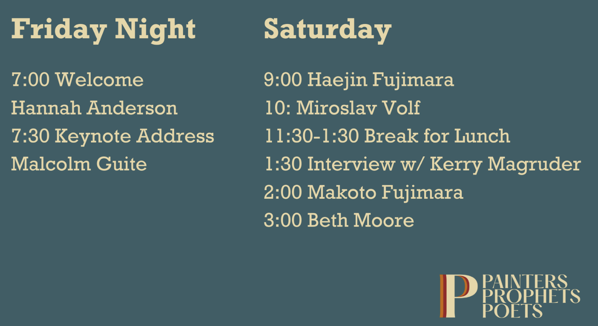
This October 4-6, Oklahoma City will welcome a firmament of stellar speakers and a Milky Way of radiant participants to the Painters, Prophets, Poets conference, subtitled “Imagining New Creation Together.”
Hosted by Travis Lowe and Hannah Anderson, speakers are Malcolm Guite, Makoto Fujimura, Haejin Shim Fujimura, Beth Moore, and Miroslav Volf. Around 400 people have registered from 30 states plus Canada. Most of the top 10 states lie between the Rockies and the Appalachians. An explicit goal is to encourage the growth of collaborative communities in the central plains.
Learn more and follow conference updates at Facebook and Instagram.
After registration, conference participants hear about various auxiliary events. One of those is touring the OU History of Science Collections…
Invitation:
Today, you are a researcher. This is a privilege and a dare.
Beware, the books will change you. Let him who has ears to hear…
I pray you will find one that speaks to you.
One that rouses your imagination like the Oklahoma winds.
One that strengthens you with the comfort of the companionship of a true friend.
Enter in hope, all ye who enter here.

Experiencing the History of Science Collections as part of this conference will not be like visiting a museum; our conversation together will be much more personal than that. Come with your heart open to allow the beauty of these physical traces to draw you into the invisible reality of the communion of the saints, the communities of scientists, artists, and lovers of creation who have gone before. Bring your journal notebook (pencils good, but no pens). Phone photos welcome. Space is limited. Register first, then you can sign up. With apologies, no rain checks; it is not available on other dates.
Recommendation: Download a copy before the tour, and read the first few pages to orient you to the History of Science Collections and what we’ll be doing. First we’ll enjoy a whirlwind tour; then after that you can go back and look at one or two books with greater care and attention (consulting the meditations if you wish just for those select items). This PDF contains all the meditations that are set next to the books during the tour, but don’t try to read them all at once.
In the weeks after the tour, read the meditations at leisure, like a book of poems, selectively, and as you have time to inwardly digest them.**
Then, as the desire to know and the love of understanding wells up as courage within you, come back, register as a researcher, and ask to see the original books in the Reading Room!
At the conference I look forward to meeting you in person. Before then, I hope to read your introduction on the private Facebook group. See you soon… I can’t wait!
** Note: The meditations are not written to be read in an informational mode like one might employ to scan an article at Wikipedia. They are not what Siri might speak back if you asked her for a caption. Read them like poems. Within the frame of a given form or structure the creativity of a poem emerges; it is the same for these reflections. Think of the materiality of the books and historical knowledge of the events as analogous to the form or structure of a poem. While writing within that frame to the best of my ability, these are meditations, interpretations, my gifts of gratitude to the speakers, organizers, and participants of this conference. Tip: You may find it helpful to read them aloud.
PS: Yes, you are welcome to come back as a researcher. You do not need to be an academic scholar. There is a registration process. After that, the books will be brought to you in the Reading Room (max of five at a time). It’s good to request the books in advance so they can be pulled and waiting for you. All this is explained on the web page for the History of Science Collections. The information at the top of each page in the reflections PDF is sufficient to make a book request. Go to the University of Oklahoma Libraries website (libraries.ou.edu) and navigate to the page for the History of Science Collections. There you can register online, request the books you want to see ahead of time, and ask any questions you have for Collections staff. And then come and sit with the books.

George MacDonald bookmarks.
Auxiliary educational resources for the weeks AFTER the tour:
If your time among the books on this visit prompts you to explore further, numerous excellent educational resources are available online and in your library and local bookstore. Depending on your interests, I’ll be happy to make some recommendations if you want to get in touch. To help you get started diving deeper into any of the topics raised by these books, the following educational resources of my own are keyed to the number of the book as indicated in the meditations PDF.
- Earth
- #4 Aristotle on animals.
- Video: Some of the brief videos from my OU undergraduate survey class, “History of Science, Beginning to Newton,” may be relevant. The Aristotle intro is one example. From that page you can browse the entire website.
- #11 Apiarium.
- #14. Hamilton.
- Video presentation: Geohistory: Intro to the work of Martin Rudwick.
- #20-#27 Charles Darwin:
- Heavens
- #32 Hoot the Owl, by Anna Todd.
- #33 Kepler on the Star of Bethlehem.
- #34 William Schickard, Astroscopium.
- #36 Hevelius star atlas.
- #37 Bode star atlas.
- Middle Earth astronomy:
- Video presentation:
- In a public presentation, Starstruck Tonight, Candace and I describe most of the astronomical works on display in this section.
- The Sky Tonight:
The images that fuse the beauty of modern deep space photos with historic star atlases may all be downloaded at my website skytonight.org. Information about each atlas is available under the “Sources” tab. Constellation images are found under the Constellations tab, etc.
- Music of the Spheres
- #38 Flammarion flat-Earth woodcut.
- #39-#40 Peter Apian.
- #47 Copernicus.
- #49 Kepler, Mysterium cosmographicum
- #51 Kepler, Harmony of the Universe.
- #55 Einstein.
- Video: For an intro to Einstein’s theory of relativity (or “theory of relationality”), see my video lecture “Relational Physics.”
- Video: For an intro to Einstein’s spirituality and realism, see the section on Einstein in my video lecture “Knowing Kata Physin.”
- Background video:
- Art and Astronomy
- #57 Galileo’s telescope.
- #63 Niceron.
- #64 Coronelli globe gores.
- Background video:
- Hope for All Creation: From Cycles to History
- #66 Augustine, City of God
- #70 Burnet and #71 Scheuchzer
- I discuss Scheuchzer, Burnet, and others here and here, etc.
- Anatomy: From Taboo to Glory
- Interpretation: The Bible and Science
- #78-#81 Galileo.
- #82-#83 Isaac Newton.
- Video: Newton is a complex figure. For an intro to Newton’s spirituality and beliefs see the “Newton” section in my video lecture “Dualism.”
- Video: For his problematic “ancient wisdom” approach to interpreting the Bible and science, see the “Genesis” section in my video lecture “Relational Physics.”
- Bibles: Echoes of the Word Made Flesh
- #85 Geneva Bible.
- #88 King James Bible.
- #89 Walton’s Polyglot.
- #99 Schreck
- #105, “Chorus from the Rock,” Michael Barfield.
- Background video:
- Many of these examples are discussed in the Bible Translations section of my video lecture “Language and Reality.”
General resources:
- kerrysloft.com: my personal blog; search for any names or topics.
- kerrymagruder.com: my professional blog (under construction). See the “videos” tab. It also has a bio page.
- skytonight.org: my star atlas digital project.
- lynx-open-ed.org: When you see references to “lynx-open-ed.org,” those resources will eventually reappear at kerrymagruder.com. The Lynx Open Ed website crashed and no longer exists. I am slowly reconstructing it at kerrymagruder.com but right now only the videos section is useful.
- kerrymagruder.com/hsci: Some of the brief videos from my OU undergraduate survey class, “History of Science, Beginning to Newton,” may be relevant (partial list of brief course videos; course playlist at youTube).
- Love and the Cosmos: Some of the above videos are from my online course “Love and the Cosmos: Trinitarian Perspectives on Science with T. F. Torrance and C. S. Lewis.” The link is to the landing page with all the videos for that course.
None of my own educational resources above, including the meditations PDF, represent the University of Oklahoma. The views and interpretations expressed are all my own.
University web pages:
All rare book images in the meditations PDF are from the History of Science Collections and the Bizzell Bible Collection of the University of Oklahoma Libraries.
- repository.ou.edu: Many of the books displayed for this tour are digitized and available in the library’s open access online library.



